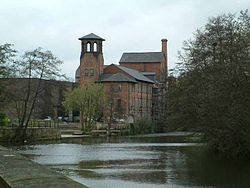Derby Silk Mill

The museum and the River Derwent
|
|
| Established | 1974 |
|---|---|
| Location | Derby, England |
| Coordinates | 52°55′33″N 1°28′33″W / 52.925833°N 1.475833°W |
| Type | Industrial museum |
Derby Silk Mill, formerly known as Derby Industrial Museum, is a museum of industry and history in Derby, England. The museum is housed in Lombe's Mill, a historic former silk mill which marks the southern end of the Derwent Valley Mills World Heritage Site.
Between 1717 and 1721 George Sorocold built Britain’s first mill for the Lombe brothers, beside the River Derwent to house machines for "doubling" or twisting silk into thread.
John Lombe's idea of mill was inspired by contemporary smaller and less effective mills he studied during the period in which he worked in Italy: traditionally the spinning wheel was used for producing small quantities of silk thread at the homes of local spinsters, the new machines were capable of producing far greater quantities of silk and provided serious competition for the Italians. The machines required large buildings and a power source. An undershot water wheel turned by the mill fleam on the west side of the new mill drove the spinning machines.
John Lombe died in 1722 in mysterious circumstances, believed to have been poisoned by an Italian assassin paid by his italian commercial opponents. His half brother, Sir Thomas Lombe, died on 2 June 1739 leaving his estate to his widow and their two daughters.
Dame Elizabeth advertised the lease for sale in 1739, and the remaining 64 years of the lease were assigned to Richard Wilson junior of Leeds for £2,800. Wilson remained in Leeds leaving the running of the mill to his partners, William and Samuel Lloyd, both London merchants, with Thomas Bennet as manager, taking a proportion of the profits.
A description of the mill by William Wilson dating from some time between 1739 and 1753 has survived:
These circular spinning machines (also known as 'throwing machines'), were the most significant innovation of the factory. Together with the single source of power (water), and the large size and organisation of the workforce for the period (200-400, according to contemporary sources), the total process of production from raw silk to fine quality thread has led the Lombes' silk mill to be described as the first successful use of the factory system in Britain.
...
Wikipedia

